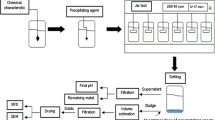Abstract
In Poland, there are significant deposits of copper ores. During the copper extraction, large amounts of flotation wastes are produced. In the ores and flotation wastes many other important elements are present. The main goal of this work was analysis of uranium content and to elaborate procedures for recovery of U from these materials. Two types of ores and four types of waste were examined. It has been found that uranium content varies from 4.5 to 25 ppm. The other elements have also been determined in these materials: Cu (4–5 % in ores and 0.3–1.7 % in waste), Ag, Re, Mo, La, Ni, V, etc. For leaching, sulfuric acid and sodium carbonates of various concentrations (temperature, time) were used. The optimum conditions for leaching have been found. The concentration of uranium in the final solution was generally less than 25 μg/mL. The other elements are also present in the leaching solutions. Simultaneous liquid–liquid extraction of uranium with these elements from leaching solution is under study. In our opinion, only such combined procedure for the recovery of uranium together with the accompanying elements could be cost-effective.


Similar content being viewed by others
References
Chmielewski AG (2008) Nuclear fissile fuels wordwide reserves. Nukleonika 53:2–11
OAR LLC. http://www.uraniumrecovery.com Accessed 04 Apr 2013
Afolabi AS, Muzenda E, Sigwadi R, (2010) Effect of reagent parameters on recovery of South Africa uranium ore. Proceedings of the 3rd international conference on uranium 40th annual hydrometallurgy meeting, Saskatoon, Saskatchewan, vol. 1. 481
Habashi F, (2010) Uranium from phosphate rock. An update. Proceedings of the 3rd international conference on uranium 40th annual hydrometallurgy meeting, Saskatoon, Saskatchewan, Vol. 1. 631
Prasser HM, (2008) Presentation: Are the sources of uranium big enough for the nuclear energy industry? In: Nuclear energy in Poland: opportunity or necessity? Conference in Warsaw, 20–21 Oct 2008
Ostrowski M, Skłodowska A (1996) Małe bakterie wielka miedź. SCI-ART, Warszawa
Leung S, Heymann L, King D, (2010). The recovery of uranium from acid leached ore using resin-in-pulp technology. Proceedings of the 3rd international conference on uranium 40th annual hydrometallurgy meeting, Saskatoon, Saskatchewan, Vol. 2. 15
Brejnak E, Pinkas K, (1975) Badania technologiczne nad przerobem łupków dictyonemowych w skali laboratoryjnej. Instytut Badań Jądrowych, Opracowanie Wewnętrzne Nr. 170/Ch-IV/75
Szymańska D, (1967) Opracowanie optymalnych parametrów otrzymywania koncentratu torowego z rudy toronośnej”H”. Instytut Badań Jadrowych, Opracowanie Nr. 45/Ch-IV/67
Brejnak E, Pinkas K, Deptułowa D. (1975) Badania technologiczne nad przerobem łupków dictyonemowych w skali laboratoryjnej. Prace uzupełniające. Instytut Badań Jądrowych, Opracowanie Wewnętrzne Nr. 171/Ch-IV/75
Acknowledgments
The studies were supported by the operative programme–Innovative Economy, POIG Project Entitled “Analysis of the possibility of uranium supply from domestic resources”. No POIG 01.01.02-14-094/09.
Author information
Authors and Affiliations
Corresponding author
Rights and permissions
About this article
Cite this article
Wawszczak, D., Deptuła, A., Łada, W. et al. Studies of leaching of copper ores and flotation wastes. J Radioanal Nucl Chem 300, 243–247 (2014). https://doi.org/10.1007/s10967-014-3011-7
Received:
Published:
Issue Date:
DOI: https://doi.org/10.1007/s10967-014-3011-7




